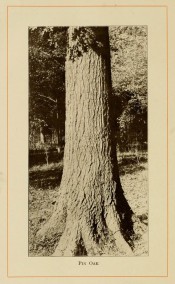Quercus palustris Münchh.
Fully-hardy, fast-growing, broadly conical, deciduous tree, with pendant lower branches, smooth grey bark, elliptic, deeply-lobed, glossy leaves, to 15cm long, turning scarlet-brown in autumn, and nearly spherical acorns. To 20m. [RHSE, Hortus, Hilliers'].
Horticultural & Botanical History
‘PIN oak ranges from certain sections of Massachusetts, notably the Connecticut river valley, and near Amherst, westward as far as the southeastern part of Missouri; on the south it is found along the lower Potomac river in Virginia, in Kentucky, Arkansas, and Oklahoma.
It is known as pin oak in Massachusetts, Connecticut, Rhode Island, New York, Pennsylvania, Delaware, Virginia, Maryland, Arkansas, Missouri, Illinois, Wisconsin, Iowa, and Kansas; in Arkansas and Kansas it is called swamp Spanish oak; in Rhode Island and Illinois it is often known as water oak; in Pennsylvania, Ohio, and Kansas as Swamp oak ; in Arkansas as water Spanish oak.
The name pin oak is said to belong to this tree because of a peculiarity of its branches. They leave the trunk and the larger limbs at nearly right angles, and criss-cross in all directions, resembling pins thrust into the wood, and bristling outward at every angle. The crowding to which they are subjected kills many of them as the tree reaches middle age, but the stubs do not drop quickly, and as many of the characteristic pins appear to be present as ever. Such is the usual explanation given to account for the name, and the facts fit the theory ; but the fact that several other species are called pin oaks is not accounted for. The habit of the branches of all of them is not the same. The Gambel oak in its Arizona range has that name. So has the chinquapin oak in Arkansas and Texas, but that is apparently a shortening of its true name, the last syllable only being used. They call the Durand oak pin oak in Texas, but without any known reason.
The botanical name palustris, belonging to this species, refers to the tree's habit of growing in swamps and damp land along river bottoms. It is not a swamp tree as cypress is, but is more like swamp white oak, and finds its most congenial surroundings on the borders of streams and on fairly well drained lowland where roots readily reach water.’ [Gibson – American Forest Trees p.301/1913]
Introduced to Europe in 1800. [PD].
History at Camden Park
Listed in the 1845, 1850 and 1857 catalogues [T.808/1845].
Notes
Quercus palustris Torr. & Gray = Quercus rubra L.
Quercus palustris Rugel ex A.DC. (1864) = Quercus coccinea Münchh.
Published Feb 03, 2010 - 04:54 PM | Last updated Jul 31, 2011 - 05:00 PM
| Family | Fagaceae |
|---|---|
| Category | |
| Region of origin | Eastern USA |
| Synonyms | |
| Common Name | Pin oak |
| Name in the Camden Park Record | |
| Confidence level | high |


